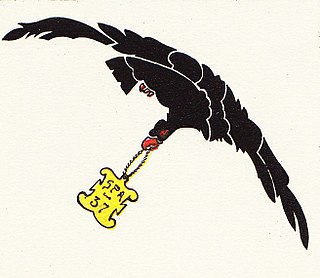
Escadrille 3Les Cigognes was a famous French aviation unit during the World War I. It was often referred to as the 'Stork Escadrille N3' due to its insignia. Pilots from Groupe de Combat 12 adopted the name and placed images of storks in different phases of flying on their planes.
Groupe de Combat 12 'Les Cigognes' was the most celebrated and successful French Air Service Groupe de Chasse during the World War I. Its roster included Georges Guynemer, René Dorme, Alfred Heurteaux, René Fonck, Raoul Echard, Joseph-Henri Guiguet, Roland Garros, Mathieu Tenant de la Tour, Jean Laulhé, among other French World War I aces. The fliers from CG 12 carried different stork insignia on their planes.

Escadrille 12 of the French Air Force was formed in 1912 and known for introducing Nieuport aircraft to the World War I air combat.

Escadrille 26 is a squadron of the French Air Force founded in 1914 and still active today.

Escadrille 73 of the French Air Force originated at Corcieux on 23 May 1915 as Detachment N 49 during the World War I.
Escadrille 62 is a French Air Force squadron. It was founded on 11 August 1915 at Lyon–Bron Airport.
Escadrille 65 of the French Air Force was established during World War I. It was founded at Lyon-Bron Airport on 2 August 1915.
Escadrille 67 of the French Air Force was founded at Lyon-Bron Airport during the First World War, on 17 September 1915. On 24 September, they were assigned to the IV Armee of the French Army. By late October, the escadrille was assigned to the defense of Verdun.
Escadrille 15 is one of the oldest units of the French Air Force, which was founded on 22 August 1912 at Reims, France, and is still active.

Escadrille 31 of the French Air Force was founded at the beginning of the World War I, on 24 September 1914, at Dijon Air Base. Once equipped with Morane-Saulnier Ns, it was posted to I Armee of the French Army.

Escadrille 37 of the French Air Force was established at Chateauford, France in January 1915. Its original equipment of Morane-Saulniers led to its original designation of Escadrille MS 37.
Escadrille 57 of the French Air Force was founded during World War I, on 10 May 1915.
Escadrille 38, variously known as Escadrille MS38, Escadrille N38, or Escadrille SPA38, was a French fighter squadron founded on 8 January 1915. Fighting until the 11 November 1918 armistice, they were responsible for downing 98 German aircraft in aerial combat.
Escadrille Spa80 was a French fighter squadron active during World War I, from 13 December 1916 to 11 November 1918. It was credited with 23 aerial victories.
Escadrille Spa.86 was a French Air Force fighter squadron active from 6 April 1917 through the end of World War I. They served as a component of Groupe de Combat 14, and were Cited in orders on 28 October 1918 for having downed 30 German aircraft.
Escadrille Spa.81 was a French fighter squadron active in World War warfare during 1917 and 1918. With nine flying aces in its ranks, it downed 88 German aircraft. It was twice Cited in orders and entitled to the Fourragere of the Croix de guerre.
Escadrille Spa.102 was a French fighter squadron founded in 1913. It served throughout the First World War in a variety of aircraft types, claiming 85 aerial victories, of which 18 were approved.
Escadrille Spa.77 was a French fighter and photo reconnaissance squadron active from 1916 to 1918 during the First World War. They were credited with the destruction of 34 German airplanes and observation balloons, as well as extensive photo intelligence coverage of enemy positions.
Escadrille Spa.112 was a French air force squadron active for the near-entirety of World War I. After serving until mid-1917 in various iterations of a bombing squadron, they were re-equipped with Nieuport fighters. With their Nieuports, and their subsequent SPADs, they destroyed 28 enemy airplanes by the ceasefire.
Escadrille Spa.68 was a French fighter squadron active from Autumn 1915 until the Armistice that ended World War I. It was equipped with a mixed lot of Nieuports until they were gradually replaced by SPADs in November 1917. The squadron was one of four bundled into Groupe de Combat 20 in February 1918. By war's end, Escadrille Spa.68 was credited with the destruction of 15 enemy aircraft.







